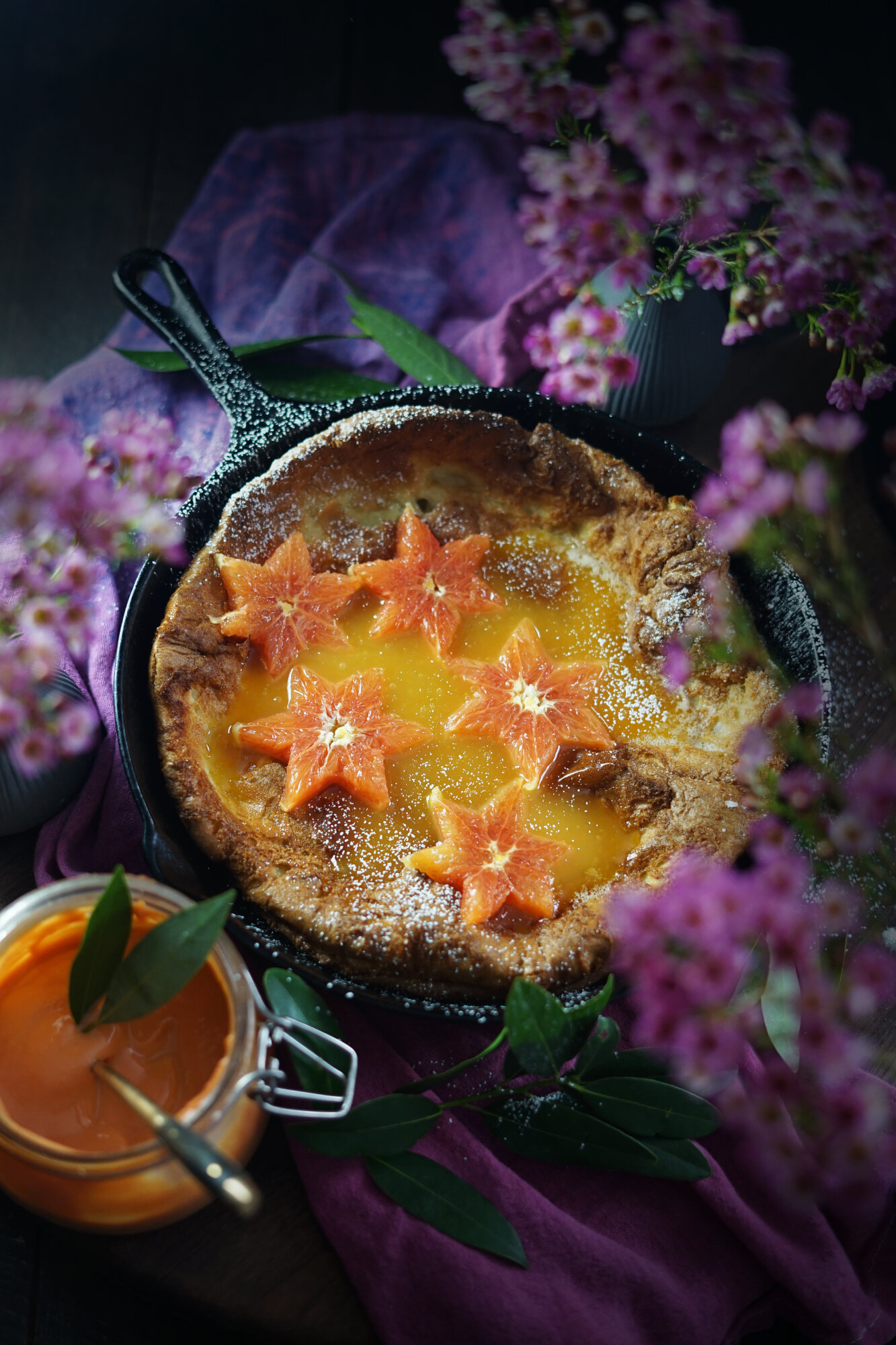Winter Bay Magic: Puffed Oven Pancake with Bay-Infused Citrus Curd
New to foraging? Learn more about ethical and safe foraging (plus how to get started) here!
My back against the sturdy trunk of a laurel tree, I closed my eyes and breathed in its complex, perfume-like fragrance. At first, I was hit with resinous balsamic notes with hints of spices, particularly nutmeg and just a touch of mint. Hiding beneath those strong scents was something vaguely citrus-like, rounded by a soft honey-vanilla sweetness. I felt pure, grounded pleasure exploring this magnificent tree with my olfactory senses and dreaming up uses for those aromatic leaves. I also felt a profound sense of safety and peace after a traumatic experience just days before. In fact, I had been so drawn to this tree that I pulled over into the nearest pull-out and hiked up to visit it, pulled there by invisible forces. I guess something in me just knew that I needed a little Bay magic.
Bay leaves are most often used to add depth of flavor to long-cooked soups, stews, and other savory dishes. But why stop there? That delectable perfume need not be limited when it is so full of life and symbolism!
Humanity has embraced bay leaves for centuries. In ancient greek and Rome, they represented honor and success, which is where the term “poet laureate” comes from. (In fact, some believed that if you tucked a bay leaf under a boy’s pillow, he would grow up to become an esteemed poet.) Many of the leafy crowns of nobility depicted during this area referenced Bay Laurel, and a wreath of it was the prize at the precursor to today’s Olympic Games.
With such a strong association with people of nobility and power, bay soon became seen as a talisman of protection against sorcerers, poisoners, and even lightning! It was seen as a means of purification as well, especially when burned. A common ritual is to write a wish on a bay leaf and then burn it to achieve your goal. (Or, similarly, to write your burdens or fears instead and burn the leaf to release those.)
Bay is also a sacred herb of oracles and is an instrument of prophecy and divination. Its clarifying fragrance has lent itself to many prophetic or divinatory rites, many still practiced today. This, no doubt, has something to do with its narcotic and stimulant properties when consumed in large amounts, which allegedly aided the Delphic prophecies. (It is not recommended to consume bay leaves yourself.) One particularly charming ritual for this time of year is that rosewater-dipped bay leaves were tucked under pillows or strewn across beds to encourage prophetic dreams of true love, particularly on St. Valentine’s Day.
Whether you are seeking success, clarity, protection, or prosperity, bay holds significant symbolism that feels particularly relevant this time of year.
“A crown of bay good fortune brings
To poets, cooks, scholars, kings.”
-Carolyn Dille and Susan Belsinger
Both Bay laurel (Laurus nobilis, Lauraceae) and California Bay Leaf (Umbellularia californica, Lauraceae) can be found growing in more temperate regions of the Pacific Northwest. They are similar in flavor, with the California Bay being a little more pungent with slight minty flavor along with the nutmeg and balsam notes present in both.
*A note on safety: some members of the laurel family (such as mountain laurel and cherry laurel) are visually similar to bay leaves, but are poisonous to humans. If you are foraging your own bay leaves, make sure you are positive in your identification!
Puffed Oven Pancake with Bay Citrus Curd
If you are so inclined to tuck a bay leaf under your pillow to encourage creativity or prophetic dreams, why not take its symbolic magic one step further by infusing it into a dreamy, sunshine-filled breakfast? It gives a divine complexity of flavor to a mixed citrus curd, which tastes particularly incredible nestled into a fluffy puffed oven pancake (also known as a German Apple Pancake or Dutch Baby.) The custardy, crisp, fluffy texture of the pancake is amazing with juicy citrus and silky curd. Add some fresh citrus and toasted coconut flakes and you have a breakfast nearly as magical as you are. This breakfast is gluten-free, and can be made dairy free by substituting your favorite vegan butter for the butter in the recipe.
Bay Citrus Curd:
5 Tbs. butter, cubed (or vegan butter)
⅓ c. sugar
2 eggs
3 egg yolks
1 c. total citrus juice (I recommend a blend!)
4 tsp. Citrus zest
1 fresh bay leaf
Directions:
Add everything to a medium heavy-bottomed saucepan and heat slowly over medium heat, whisking constantly.
Once the mixture has thickened so that it coats the back of a wooden spoon and you can drag your finger through it, remove from heat and immediately strain through a sieve.
Puffed Oven Pancake:
This fluffy, eggy, delicious treat is best served hot right out of the oven, when it is puffed and piping hot! As it sits, it’ll deflate a bit… but fear not, it still tastes incredible. A couple of tips: make sure your eggs are at room temperature (it’s best to leave them out overnight) and make sure your cast iron skillet is nice and hot before you pour in the mixture.
Ingredients:
2 Tbs. butter (or vegan butter)
3 large eggs
½ c. coconut milk
1 tsp. honey
2 tsp. Vanilla extract (or 1 tsp. Vanilla bean paste)
½ c. gluten-free flour blend*
Pinch of salt
Toasted coconut flakes, to top
Variety of citrus, sliced and cut into star shapes, to top
Directions:
Preheat the oven to 425F and place the skillet in the oven to heat while you prepare the batter.
Add the coconut milk, honey, vanilla extract, eggs, gluten-free flour, and salt to a blender. Before you begin blending, add the butter to the (now very hot) saucepan in the oven. Blend the batter well.
Using an oven mitt to protect your hand, remove the hot cast iron pan from the oven and swirl the butter to coat the bottom and sides evenly. Pour the batter into the middle of the pan and put it back in the oven, then bake for 20-25 minutes, or until puffed and golden brown.
Immediately top with citrus curd, citrus slices, and toasted coconut flakes and serve hot!
*my go-to gluten-free flour blend is simple: 1 part (by volume) tapioca starch to 1 part (by volume) white rice flour. Add 1 tsp. Xantham gum for every four cups of the mixture and mix well to combine.
Tips:
The oven, pan, and butter all need to be HOT. I recommend preheating the oven with the skillet inside, then adding the butter a minute or two before you’re ready to pour in your batter. It’ll melt fast.
Pouring the batter in immediately after mixing it gives a better rise.
The easiest way to mix the batter is by using a blender!
Love what you’ve read here? Don’t forget to Subscribe to get frequent updates of new posts!
Huge thanks to my Patrons that make sharing all of these lovely posts with you possible (without all of the pop-ups and ads that make browsing other blogs so annoying). If you’re feeling generous, you too can support the wonder with a monthly contribution of your choice. Even $1 helps a lot! Your donation will help to fund this blog as well as my surprise free events and gifts for strangers. Learn more about this program at the link below:




















Join me for a little winter night magic as we bake this cake full of rich seasonal flavors and black cocoa!